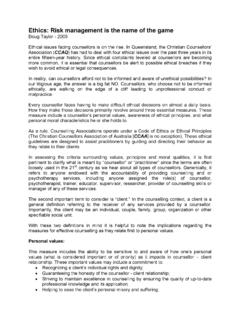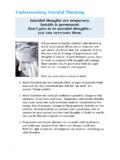Transcription of Using the Creative Arts in Grief Therapy
1 Counselling ____ Connections Across Australia 2001). Most importantly self-expression must be heard and validated by the therapist. Where I have used the terms art practice , Creative arts and end product I refer to any of the disciplines of the performing and Creative arts . Though there are specialists in the various artistic disciplines (art therapist, music therapist, drama therapist etc) there is room to adopt the use of the arts by non-specialist therapists. In the realm of Grief and bereavement counselling the use of an artistic discipline may be a new way for the bereaved to communicate when words seem inadequate. The arts can transcend cultural differences, be pertinent in different ways through generations and give voice to an otherwise inaccessible inner self.
2 Give sorrow words, yes, but also paint and glue and hammers and nails and long walks and quiet and music and play and all other possible forms of expression, including silence. In this essay I will define the term Creative arts and the arts can fit with contemporary Grief and bereavement research and theory. I will look at how various aspects of the arts can be applied to children, adolescents and adults, those who are instrumental grievers and those who operate in a more intuitive fashion. I will look at example of artists who have used their art to respond and comprehend losses in their own lives and how art appreciation can be used in a counselling setting. DEFINING Creative arts IN Therapy Creative Art Therapies or Expressive Therapies apply the various disciplines of the Creative arts art, music, drama, dance and written communication to the Therapy scenario.
3 The client s imagination is engaged though artistic expression to enhance healing and growth. Emphasis is placed on the process of art making rather than the final aesthetic product. Thus Using Creative arts in Therapy is not for entertainment purposes but as an alternate communication tool of self-expression (what (Schuurman 2002) CONTEXT OF Creative arts Therapy WITHIN BEREAVEMENT COUNSELLING The practice of the Creative arts in a constructivist and narrative approach can be a great tool for the counsellor to help the client reconstruct meaning in the light of their loss. To give voice to the inner turmoil, unanswered questions and a retelling of events benefits the client s physical and emotional wellbeing (Pennebaker 1990). As the bereaved deal with the shock of a new uncharted life in light of a profound loss, transformation takes place through a relearning of the world (Attig 1996).)
4 This is generally done in an organic way. Feeling though a process often requires little extra professional support as the bereaved learn to love their dead in their absence (Attig 2000). It is when this relearning takes on a regressive rather than a progressive path that intervention and cou nselli ng is requi red. Neimeyer of fers so me Using the Creative arts in Grief Therapy BY CORRIE INEI turns out to be not a state but a process Lewis (1976) Coming to terms with a loss is one of the biggest challenges one may encounter in a life span. Often the tr adit ion al wa ys of com muni ca ting our experie nce fail. Words seem inadequate and a place to begin too o v e rw hel m i ng to pi np oin t . T he e xpe r ien c e n eed s expression but an expression that is adequate, socially permissible and honouring of that which is lost.
5 The use of Creative processes may embellish a cognitive response to Grief that engages the sometimes inaccessible emotive self. A s t h e b e r e a v e d d e a l w i t h t h e s h o c k o f a new uncharted life in light of a profound loss, transformation takes place through a relearning of the world (Attig 1996). This is generally done in an organic way. 35 Counselling Connections Across Australia applications of narrative repair (2001) in various forms of self-expression and self-exploration through the use of writing exercises such as reflective journaling, writing narratives from the perspective of others and writing unsent letters. This can be further enhanced by the use of other art expressions as non-verbal communication of a life narrative.
6 For example, the use of drawing as a medium to tell stories enables the client to use a visual language that is able to put some distance between pain, emotion, behavior and themselves. Drawing bypasses the cognitive level yet thought and feelings are still externalized (Malchiodi 1990). The use of the Creative process sits comfortably in the dual process model ( Stroebe and Schut 1999) in both the loss and restoration oriented coping strategies. Music for example is generally considered as a form of entertainment or recreation and thus fits very easily in the restoration stressor as a distraction from Grief . Because of this association music can gently crossover to a role in active Grief work such as talking about or listening to music that reminds the client of the loss.
7 CHILDREN AND DRAWING Due to a child s limited verbal development the arts are a natural bridge to expression and understanding. The immediacy and accessibility of drawing permits the child to access inner issues in a way that can easily be shared with another. As children draw before they can write it is easy to observe that drawing tends to be a natural communication tool to express what can t be said in words (Bertoia 1993). Children s drawings as a legitimate expression of a narrative seems to be well recognized. One school of thought believes children with a terminal illness have a pre-conscious knowledge of their illness and outcome (returning health or impending death) that show up in their drawings (Bach as cited in K bler-Ross 1981 p. 66). A trained therapist is able to interpret their fears, beliefs and emotions and assist the family and child with their impending death.
8 Though there is much literature on symbolism in children s drawings there is a danger of misinterpreting and therefore misunderstanding the child s effort to communicate. A phenomenological approach should be adopted where the artwork is understood in its context and in it s own right rather than depending on preconceived causes (Malchiodi 1990 p 35)..the use of drawing as a medium to tell stories enables the client to use a visual language that is able to put some distance between pain, emotion, behavior and There is less research available on the use of children s drawing s in the con tex t of deal ing wi th g rief a nd bereavement compared to those with a terminal illness and sexual abuse. However, Malchioli s use of the drawing process in children s Therapy can be adapted to those dealing with bereavement.
9 As a drawing is executed in the presence of the counsellor, great insight into the thoughts of the child can be gained as questions are asked and the child talks about the various element of the drawing. The child is then able to externalize the issues they are concerned with through their drawings as they talk about it and the counsellor gains a clearer understanding of the child s thought processes. The emphasis lies on the process and development of the art making. How the ideas and thoughts are conveyed is of more importance than the final product and therefore becomes a link between non-verbal and verbal communication. This concept can be applied to other area s of the Creative arts such as telling a story with puppets or other play scenario s, expression through dance, mime or music making.
10 RESEARCH REGARDING ADULTS AND Grief Therapy While the need for non-verbal communication with children is perhaps a logical conclusion there is also relevant application to adults. Though an adult would not so readily talk about an image as it is being executed, a small folio of completed drawings can show common motifs and symbols or a theme that can give greater insight to both client and counsellor. I found little research of the use of Creative arts in Grief Therapy in relation to adults. A study concerning p r o f e s s i o n a l s s u c h a s s e r v i c e m e n , p o l i c e a n d emergency personnel has looked at the successful use of dramatherapy as a tool to combat Post Traumatic Stress Disorder (Winn 1994 as cited in Bannister 2004 p 36 37 Counselling ___ Connections Across Australia 46).









